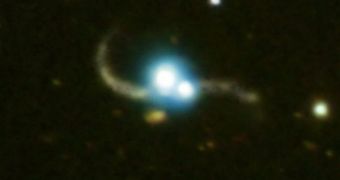Since quasars (quasi-stellar radio sources) were first identified, a scientific debate has erupted over how to best define these space structures. Some understand them as being highly energetic and distant galaxies that have an active nucleus, whereas most think that they are the compact regions in the center of large galaxies that surround a central, supermassive black hole. According to astronomers and astrophysicists, quasars are powered up by the accretion disks that exist around the black hole, and they are between 10 and 10,000 times the radius of the dark behemoth.
The reason why they are considered as being far away is because they are high redshift sources of electromagnetic energy. As light travels over great distances, it tends to suffer interferences that push its wavelength towards the red portion of the spectrum. Quasars were also found to be emitting radio waves, in point-like patterns that are very similar to the ones coming from stars, hence their name. It was only after a huge debate in the 1980’s that the scientific community came to an agreement on the nature of these peculiar cosmic objects. Recently, the NASA Chandra telescope caught two of them in the act.
The image reveals the quasar pair known as SDSS J1254+0846, which is located about 4.6 billion light-years away from Earth. The two components are, however, only 70 thousand light-years away from each other, and exert strong influences on their surroundings. The data collected by Chandra were transposed as the two bright spots visible at the center of this image. The background, as in the trails that the merging galaxies leave behind (in yellow), has been provided through observations collected by the Baade-Magellan telescope, in Chile.
“Quasars are the most luminous compact objects in the Universe, and though about a million of them are now known, it's incredibly hard work to find two quasars side by side,” says Harvard-Smithsonian Center for Astrophysics (CfA) astrophysicist Paul Green. He was the leader of the new investigation. “The tidal Tails fanning out from the galaxies that we see in the optical image are a sure sign, the litmus test of an ongoing galaxy merger,” he adds. The new data adds further credence to the idea that merging, or colliding, galaxies may be triggering the formation of quasar pairs, the expert concludes.

 14 DAY TRIAL //
14 DAY TRIAL //